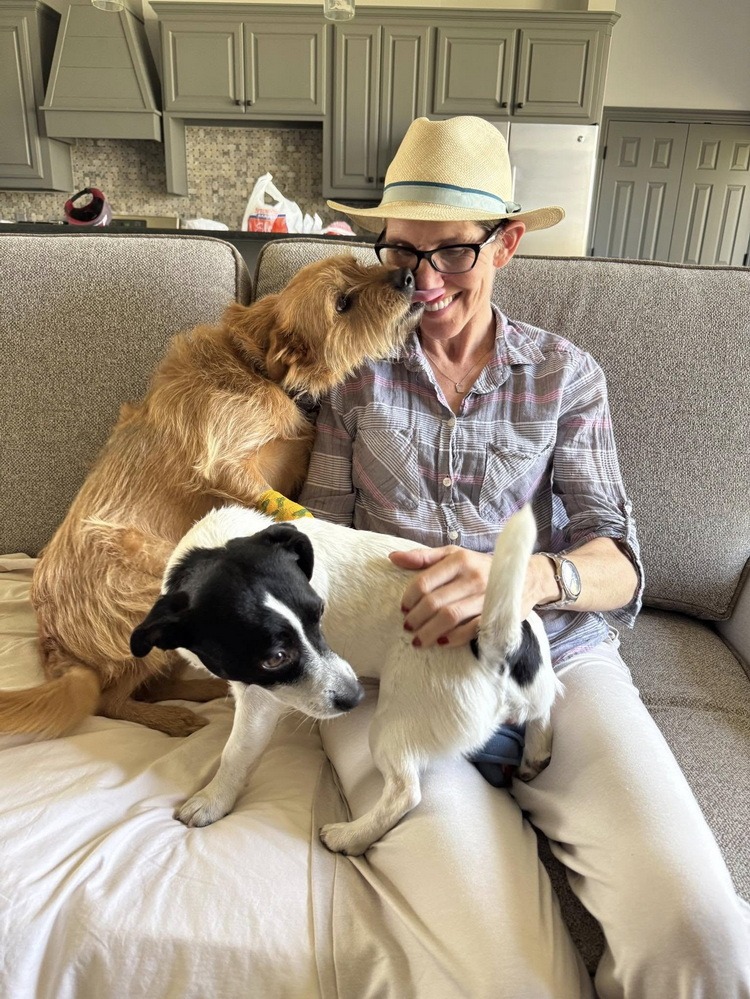by Nancy Jaffer | Apr 22, 2025
Stating that “the integrity of our sport is in danger,” U.S. Hunter Jumper Association President Britt McCormick warned during his organization’s online Town Hall Monday that there must be “zero tolerance for people that use illegal medication on horses.”
Britt, who had spoken on the topic during both the USHJA and U.S. Equestrian Federation annual meetings, was responding to a comment during the Town Hall made by Lynn Walsh, former president of the Pin Oak Charity Horse Show in Texas. Her concerns involved the overuse of medications.
The USEF in January passed an addition to the prohibited substances rule that banned from all showgrounds a list of certain injectable substances and those that are potentially deadly. The rule, which went into effect April 1, included formaldehyde and liquid nitrogen, as well as injectable pentobarbital, unless a veterinarian needs it to euthanize a horse. Rectal administration of any substance also is prohibited on the grounds of a licensed show.
Speaking about the medication issue, Britt said, “Those of us as horsemen, we have to stop this. It’s disgusting, there’s no other word for it. I think this is one of those ‘See something, say something’ -type situations. We have to be willing to stand up to our fellow competitors and say ‘Enough is enough.’
“It doesn’t matter who you are. It can be at the lowest level, it can be at the highest level. The integrity of our sport is in danger. The ability of us to compete these animals is in danger,” he pointed out.
With Social License to Operate focusing on the horse industry, the sport is under ever-increasing public scrutiny, elevated by the pervasive presence of social media.
“If we allow even one bad actor out there to use prohibited substances, we could all be in danger of losing our livelihood, losing our industry, losing our sport,” Britt emphasized.
“It’s more than just the USEF coming down on somebody and imposing a lifetime sentence. It’s more than a multiple of thousands of dollars in fines. It starts with us.”
He maintained, “Peer pressure is going to work,” suggesting that those who see something wrong should call out the perpetrator.
“The rest of us are going to back you up,” emphasized Britt, a Texas-based trainer who is also a judge.
“I for one am not going to tolerate it. As the head of this organization, I’m going to be the first one to stand up and say, `If you get caught using some of these substances, you should be banned from our sport forever, we don’t want you in it.”
He added, “until all of us are serious about it, it’s never going to get better, and it’s never going to stop. We can have all the discussion about judging and everything else. Until we take care of this root evil that’s invading our sport, the rest of this doesn’t matter.
“I think we as horse people, horse lovers, enthusiasts, sports people…we all want fairness, we all want a level playing field. We have to have zero tolerance when it comes to these medications. Going forward, again; ‘see somethings say something’ is the only way. That goes for the vets, it goes for the pharmacists, it goes for everybody.
“A trainer has to get a medication from a vet, who has to make the prescription and a pharmacy has to fill it. There’s a lot of hands touching this stuff. Until we get serious about it. It’s never going to end.”

by Nancy Jaffer | Apr 6, 2025
Sabine Schut-Kery, who clinched a silver medal for the U.S. dressage team at the Tokyo Olympics, will be offering a clinic May 9-11 to benefit Dressage at Devon in Pennsylvania as it prepares to mark its fiftieth anniversary. And at Dressage at Devon itself on Sept. 25, Germany’s Ingrid Klimke will give a masterclass. Ingrid, daughter of the legendary Olympic dressage multi gold medalist Reiner Klimke, is both a gold medal eventer and top dressage rider.
Auditors are welcome to attend the clinic at Dunmovin Farm in Pennsylvania and learn from Sabine, who gave a Masterclass at Dressage at Devon in 2022. She is known for her understanding of classical dressage principles combined with modern training techniques. From developing young horses to competing on the world stage, her expertise spans all levels of the sport. Her horsemanship, keen eye for detail and inspirational teaching style make her a sought-after clinician worldwide.

Sabine Schut-Kery and her Olympic mount Sanceo. (Photo © 2021 by Nancy Jaffer)
“Dressage at Devon holds a special place in my heart,” she said. “I look forward to sharing my foundational principles with riders and spectators in May while working with a diverse range of horse-and-rider combinations.”
Aspiring amateurs, seasoned professionals and fans are all welcome at the clinic. Sabine’s commentary and ability to break down complex concepts will provide a deeper understanding of biomechanics, harmony and precision in training, whether those who come to Dunmovin are riding or watching.
Ann Moss, president of Dressage at Devon, emphasized the significance of this event.
“Sabine has long been a beloved favorite at Dressage at Devon, captivating audiences with her performances even before her Olympic success. After hosting our inaugural Masterclass in 2022, we are thrilled to welcome her back this spring. This clinic not only upholds our commitment to education but also supports our iconic fall show.”
Riders and horse owners will have a chance to interact directly with Sabine at a private dinner hosted by Christina Morin-Graham at Oak Springs Farm in Malvern, Pa. Proceeds from this clinic will directly support Dressage at Devon’s continued success and impact within the equestrian community.
For more details on Sabine’s clinic, visit dunmovin.net/clinic. For clinic information, contact Doreen Garland at (610) 416-3839 or Dunmovinenterprisesllc@gmail.com. For more information on the Ingrid Klimke masterclass, click on this link.
Celebrating its 50th anniversary September 23-28, 2025, at the Devon Horse Show Grounds in Devon, Pennsylvania, Dressage at Devon (DaD) has been a prestigious tradition since 1975. It attracts top competitors, trainers and judges from across North America and beyond, making it one of the most respected international dressage competitions.
Dressage at Devon is a 501(c)(3) nonprofit organization with a mission centered on education and excellence in the sport of dressage.For corporate sponsorship opportunities, contact Lisa Engel at 908-310-6248.
by Nancy Jaffer | Apr 22, 2025
Noted breeder Dr. Timothy Holekamp, a former president of the American Trakehner Association, died on Sunday.
He was a founder of the Young Event Horse Program and co-chaired the Young Event Horse Committee.
The physician and his wife, Cheryl, were the owners of Windfall II, who started his career with Germany’s Ingrid Klimke and went on to earn teem bronze at the 2004 Athens Olympics with the USA’s Darren Chiacchia aboard. Windfall became a popular sire. His son, Tsetserleg TSF, was ridden to many successes by U.S. team member Boyd Martin.
Remembering Dr. Holekamp, Boyd said on social media, “He was always my go to man whenever I was trying to get an understanding of a pedigree and was a wealth of knowledge that really inspired a lot of American enthusiasts to breed Trakehner horses.”

by Nancy Jaffer | Apr 23, 2025
Although the weather forecast for the next few days in Lexington, Ky., isn’t the best, the sun shone bright (as the song goes) on the Kentucky Horse Park for the Defender 5-star eventing horse inspection Wednesday.
Boyd Martin had three horses he showed to the judges, but perhaps his best shot at victory is with his Olympic mount, Federman B. (His others are Luke 140 and Commando 3).
You have to figure, though, that the combo to beat will be Germany’s Michael Jung and fischerChipmunk FRH. As past winners, they are hard to bet against, and Michi’s record in the sport is unsurpassed.
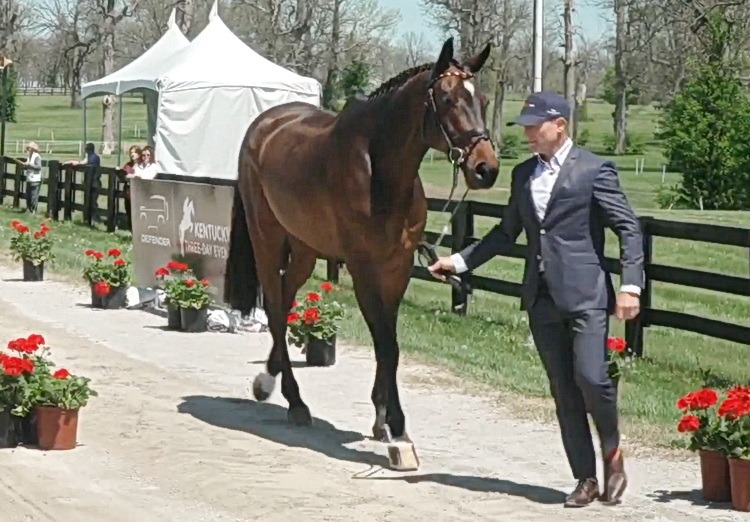
Michael Jung and fischerChipmunk FRH.
Sadly, Jennie Brannigan’s ride, Twilight’s Last Gleam, was not accepted after being re-presented following a stint in the holding box. That was the only entry to be rejected.
Jennie was gracious about her 15-year-old mount’s fate, noting owners “Tim and Nina Gardner and myself love this horse and he owes us absolutely nothing.”
No worries, though; we’ll still see Jennie in competition. She will be able to compete on FE Lifestyle in the field that has been narrowed to 34 starters.
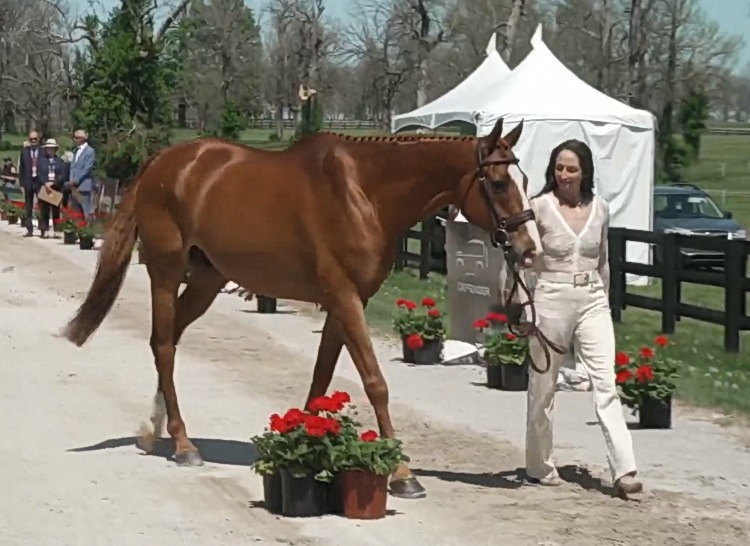
Jennie Brannigan and the beautifully turned-out Twilight’s Last Gleam sadly got a “no” from the judges.
The most eye-catching horse is Fluorescent Adolescent with a coat of splashy spots. He’s ridden by the only Canadian competitor, Jessica Phoenix.
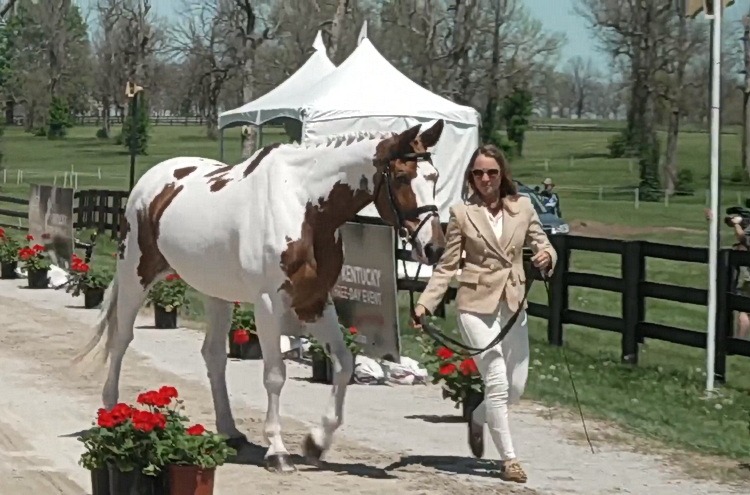
Jessica Phoenix and the Flourescent Adolescent.
The 5-star trot-up is always a fashion show, and my choice as the best-dressed is New Zealand’s Monica Spencer, who will be riding Artist. She wore black leather pants and a cape-like checked top in a shade of oatmeal, both stylish and classy.
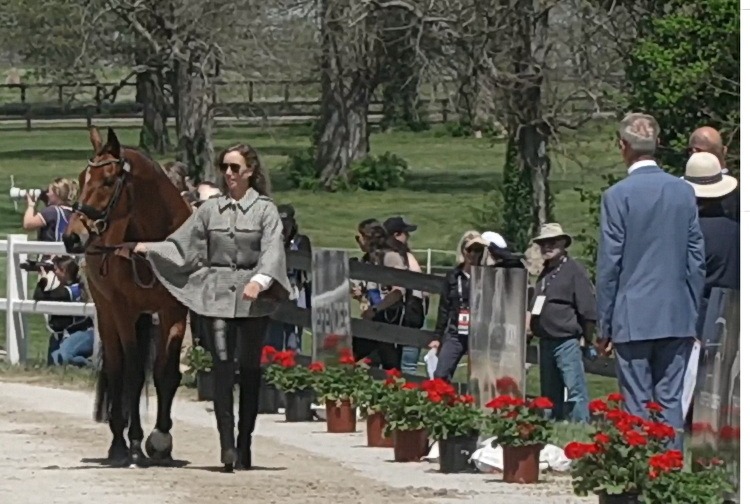
Monica Spencer and Artist.
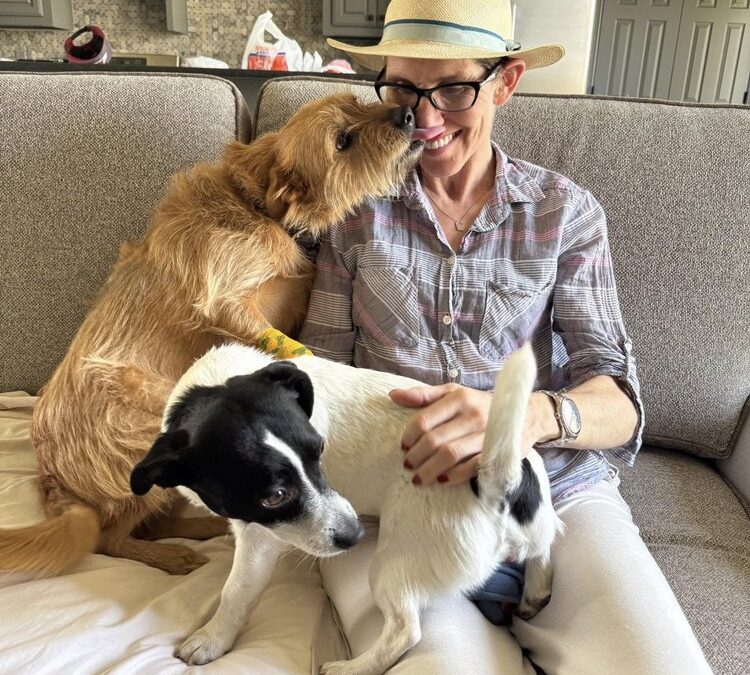
by Nancy Jaffer | Apr 19, 2025
Olympic eventer Liz Halliday, who suffered a traumatic brain injury in a cross-country fall last August, has reached out to her many friends and fans who have been following her recovery. Here is what she said on social media Saturday:
My voice is getting stronger all the time, and until I can talk to you all in a video, I’m writing to you with help from my family and friends. In a normal week, I would be busy making final preparations with my horses to compete in the Land Rover Kentucky Three-Day Event. But as you know, my new normal is now focused on my recovery from a traumatic brain injury.
No two recoveries from a TBI look the same, and I feel grateful for the progress I’ve made so far and know I will continue to make. After spending six months at the Shirley Ryan AbilityLab in Chicago, I have now moved to Dallas to continue my therapy at the Centre for Neuro Skills (CNS). Every day is filled with speech, occupational, and physical therapy with a focus to getting me back to doing what I love.
I’m so grateful for all of the messages of love and support I continue to receive. Above all, I am grateful to my family and friends for their continued support, and that my dogs, Archie and Ella, were able to move to Dallas with me and are staying with friends nearby. I am living in my own apartment now at CNS with the support of a dedicated care team, and every day my life feels a bit more back to normal.
To my fellow competitors who are gearing up to compete at Kentucky, I wish you all the best for a safe and successful competition. My heart will be with you all this week! Hug your horses and your people tight, and I look forward to seeing you all soon.
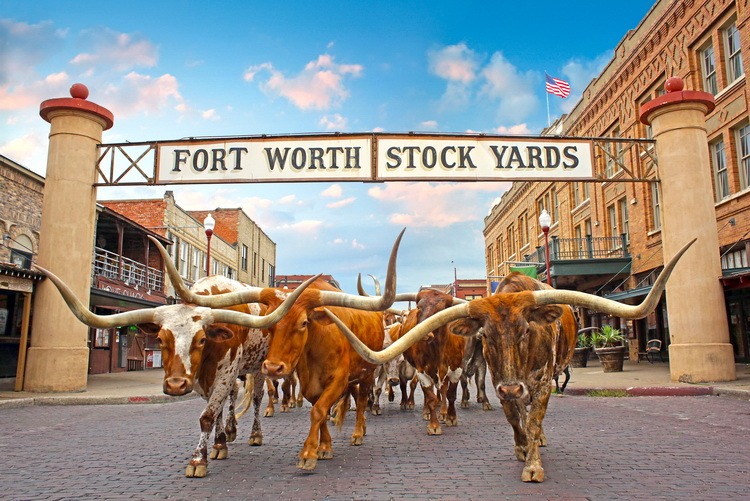
by Nancy Jaffer | Apr 18, 2025
I’ve attended 25 World Cup Finals since the first one held in the U.S. in 1980. Aside from a few special touches, most were like your average fancy European horse show, such as those staged when Volvo was the Cup sponsor in its home city of Gothenburg, Sweden. On the fun side, those finals were known for their fantastic flower arrangements that made it difficult to see some of the jumps. And then there was the indoor lake on the course at Dortmund, Germany, in 1990.
But the game changers that redefined the Cup competition were the glitzy finals complete with fireworks in Las Vegas. That wildly popular series debuted in 2000 and ran in 2003, 2005, 2007, 2009 and 2015. Covid sadly cancelled the 2020 edition. It seems unlikely that Vegas, which put the dressage and show jumping Cups together for the first time, will be held again in the near future.
But now we can look forward to another innovative Longines FEI World Cup Finals, scheduled for April 8-12, 2026 in Fort Worth, Texas.
Derek Braun, whose Split Rock Jumping Tour is putting on the finals, promises iconic longhorn cattle will be part of the scene. Indeed, longhorns are driven through the stockyard in an exhibition twice daily. You can’t miss it. So polish up those cowboy boots and grab yourself a 10-gallon hat to fit right in.
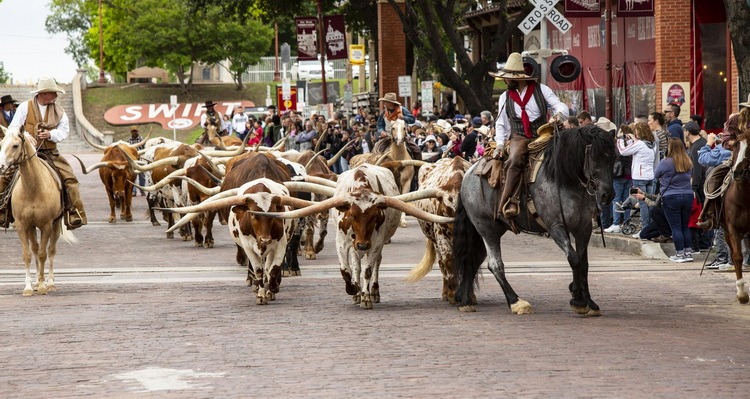
A twice-daily cattle drive is a feature in Fort Worth. (Photo courtesy Dickies Arena)
“We’re going heavy with the Texas vibe, very western, very cowboy, very cow country-oriented. Which is what Fort Worth has to offer. I think it’s going to be a fun, cool, new exciting fresh take on it,” advised Derek, who noted accessibility of the massive Dallas/Fort Worth International Airport means the Cup destination is only one flight away from almost anywhere in the world.
With the 2024 Cup in Basel, Switzerland now behind us this month, it’s time to start making plans for next year’s dressage and show jumping finals. Fans already are buying tickets for the Fort Worth competition, to be held in the state-of-the-art Dickies Arena, adjacent to the Will Rogers Memorial Center.

Dickies Arena will host the 2026 Longines FEI World Cup Finals (Photo courtesy Dickies Arena)
Derek was in Basel to accept the hand-off of the Cup finals flag and look at the “inner workings” of the Swiss version of the Cup. There are quite a few differences between the 2025 and 2026 host sites and their offerings.
“Our schedule is a lot lighter than theirs was, they had another 3 star (show jumping) and vaulting. Their days were extremely long,” Derek observed.
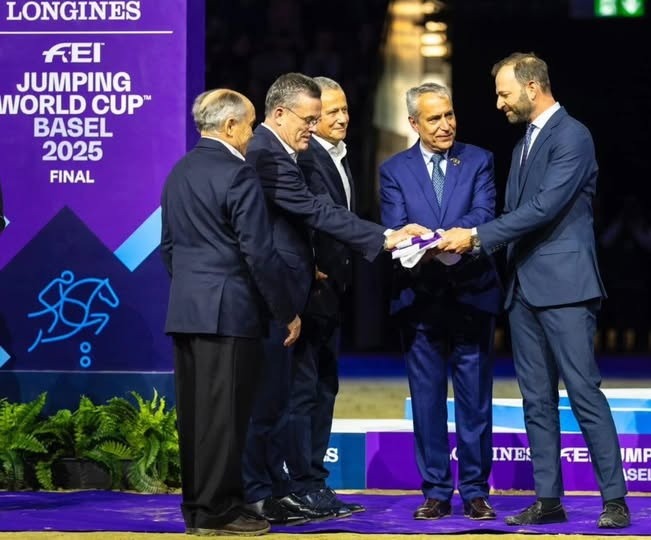
Derek Braun accepts the Longines FEI World Cup flag in a hand-off at the end of the Basel show. .(FEI Photo)
“Our days are focused toward just the World Cup sessions. Footing is a major priority for me, we’ve already mixed our footing six months ago. Riders want to make sure the details are absolutely perfect for them.”
While Basel used tents for stabling and warm-up, everything at Fort Worth is permanent.

The interior of Dickies Arena. (Photo courtesy of Dickies Arena)
As Derek pointed out, “there are not many comparable arenas worldwide to Dickies, there’s not a bad seat in the house.” There will be 9,500 of them for the Cup finals. VIP space is limited, so early purchase of tickets is urged. They are available separately for the dressage sessions, jumping sessions and all sessions. Tickets are available at https://www.fortworth2026.com/tickets. VIP reservations can be made at VIP Reservations.
Although Derek’s management resume does not include a dressage show, he’s educated on the details required. But he emphasized that discipline will be guided by Thomas Baur, the German who runs the Adequan Global Equestrian Festival in Wellington, Fla.
Speaking about Dickies, Thomas said, “I think it’s probably the best venue for a World Cup I’ve seen in this country. There is enough space; for the horses, it will be easily accessible. The plan is to have a vendor and action area between the main ring and the last warm-up ring, so I think that will be great for the spectators. I was there in December and there are a lot of nice restaurants and hotels close by.”
In Fort Worth, he notes, there are “a lot of things to do for people who want to come to the World Cup. It’s absolutely fun.”
Derek is hoping qualifying participation will go “through the roof.” He called the new venue, “A little bit of an ode to the old Las Vegas World Cup finals days, when people got really excited to go to Las Vegas for everything they have to offer. Fort Worth is just as exciting of a town as Vegas, in different ways.
“There’s going to be a lot of activities, the whole town is really going to embrace it and people are going to be able to make a four- or five-day vacation out of this championship.”
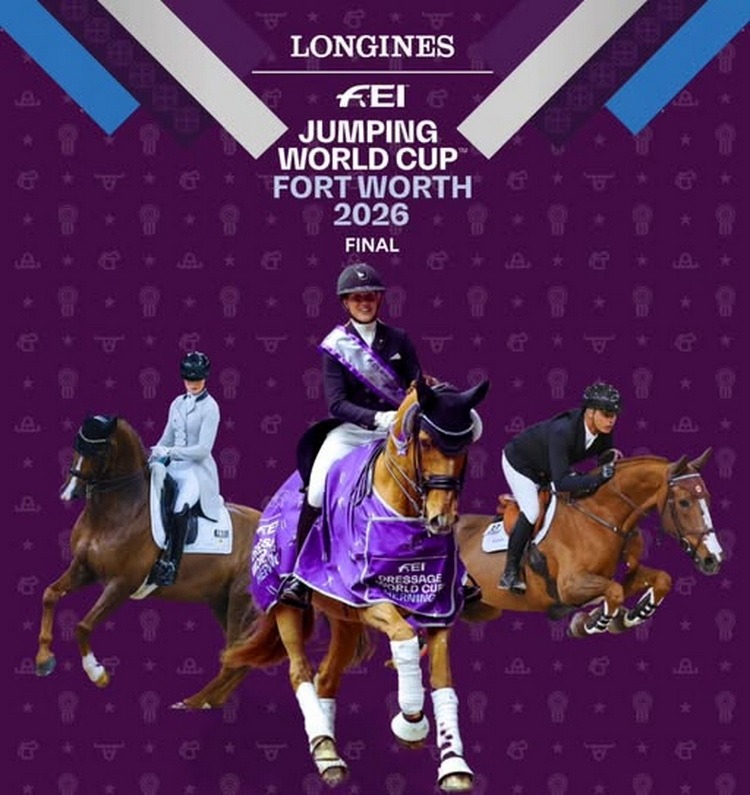
Derek explained “the city is a major partner of ours for the final. The entire city is going to be laying out the red carpet. Everyone will be connected city-wide for this final, the restaurants and businesses.”
Two clinics, one each on jumping and dressage, will be presented by professionals from the top 10 lists in their disciplines, who are yet to be selected.
It’s not all clear sailing, however.
“In the state of Texas, we are battling a little bit against the FIFA World Cup (soccer) finals and differentiating between the two,” Derek mentioned.
The 2026 FIFA matches will be held in Dallas Stadium during June and July; thus there is potential for public confusion, even though the Longines FEI World Cup is two months earlier.
“We don’t have major (show jumping and dressage) events in Texas, we were the first ever FEI event in the state four years ago,” Derek said.
So Cup organizers are launching “a year-long strategy on promotion and education of what this is. When people see an ad or image,” he observed, “they understand what it is and the magnitude behind it. FEI and USEF are helping make a big push to advertise the World Cup League.”
The crowded equestrian calendar has another major competition in 2026, when world championships in dressage and jumping (as well as several other disciplines) are being held during August in Aachen, Germany.
“I’m hoping it doesn’t affect us negatively; it’s something I’ve thought about,” Derek said.
“Texas is such a new and incredible draw that I think we’ll stand on our own. It’s far enough away from the world championships that it will be a good stepping stone for them (championship contenders) and their horses.”
In terms of both participants and spectators, Derek believes going west is a draw, especially for people from other parts of the world.
“I think people are really intrigued by the culture. They really want to experience it; they know it’s going to be new, cool and different. Any time there’s a scenario like that, it always intrigues riders from everywhere. We’re going to make sure we let every rider experience the true Texas culture.”
At the same time, he added, “I think participation for people competing from North America will be through the roof.”
For more information about the finals, go to https://www.fortworth2026.com/.
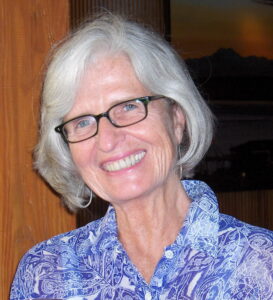
by Nancy Jaffer | Apr 16, 2025
The heart of Beval Saddlery was Lois Walter, a much-admired woman who died Tuesday from cancer at the age of 91.
She had been married to Bev Walter, who founded the business in 1955 in Bernardsville, N.J. After Lois and Bev divorced, he died in 1993. Lois went on to run Beval’s, which was synonymous with quality in English tack, working with her son, Mark, and her husband, Tom Spinks.

Lois Walter. (Photo courtesy Lori Jonas Seppi)
In addition to the stores in Gladstone, N.J., New York State and Connecticut, at its peak, Beval’s also had a mobile unit and shops on the HITS showgrounds in Saugerties, N.Y., as well as at the Winter Equestrian Festival in Wellington, Fla. The company was sold and now operates out of Cross River, N.Y.
Lois retired at the age of 80 and moved to Arizona with Tom. A master gardener, she also kept busy doing artwork and enjoying nature on her walks. The couple relocated to Utah two years ago.
Writing on social media, former Beval employee Jennifer Gomez Hoffman said Lois had been “an incredible mentor,” noticing she had hired her at Bevals when she was just 16.
“I worked for her for 14 years until I started my family. Her knowledge of the saddlery business was incredible…. I was a sponge and she saw that and shared all of her wealth of information with me. She was kind, strong and humble…always preferring to be behind the scenes. She was pure class and grace.”
In addition to her husband and son, Lois is survived by her daughter, Lori Jonas Seppi, who worked as a sales rep for Beval; five grandchildren and six great-grandchildren.
Arrangements are pending for a celebration of life, but her daughter said Lois wanted her ashes spread at the Jersey Shore, one of her favorite spots.
by Nancy Jaffer | Apr 10, 2025
EquiRatings gives Michael Jung and fischerChipmunk FRH a 26 percent chance of winning the 5-star at the Defender Kentucky Three-Day Event later this month. I would give him a far better chance; wise not to bet against a legend who has a raft of Olympic gold and world championship medals.
Cassie Sanger and Redfield Fyre are ranked as the most reliable 5-star cross-country combination. (Really?)
Meanwhile, EquiRatings says Will Coleman’s rider Off the Record has the highest Elo rating of all the 4 star horses entered at the event but his Chin Tonic has a 45 percent chance of winning the 4-star-Short. An Elo rating takes into account not only where a horse finishes in a class, but who it beat, their rating and the level of the competition.
Feel free to do your own handicapping.

by Nancy Jaffer | Apr 15, 2025
In case you’re wondering what swung the choice of Santa Anita Park racetrack over Galway Downs to host the 2028 Olympic equestrian competitions, comments from LA 28 Project Director Reynold Hoover may make the decision easier to understand.
As reported by Inside the Games, the retired Army lieutenant general explained the thought pattern behind where all competitions for 2028 sports will be held.
“Some zones are compact, others quite spread out,” Hoover noted.
“We’ve deliberately avoided a single-venue mindset.”
“This departure from Olympic gigantism is rooted not only in International Olympic Committee policy, which favors sustainability, but also in the practical need to deliver the Games within a private funding model,” Inside the Games pointed out.
Hoover observed that the Paris 2024 Games “served as a live testing ground for the concept of temporary, high-impact venues. Paris leaned into the spectacular, staging competitions in iconic settings like the Eiffel Tower and the Alexandre III Bridge.”
Visually stunning, yes, but, as Hoover observed in Inside the Games, logistically complex. Many of these pop-up sites required not just seating, but entire support ecosystems: catering facilities, broadcast zones, warm-up areas and secure perimeters.
“There’s a heavy price to pay for that kind of visual romance,” Hoover admitted, acknowledging that “replicating such magnificence in Los Angeles would come with significant cost. In keeping with its renewed sustainability doctrine, the IOC encourages host cities to prioritize existing venues. The real challenge involved selecting the right spaces and striking deals with their owners.”
In that context, it’s easier to understand why the proposed equestrian site of Galway Downs in Temecula, which is nearly 85 miles from LA, was dropped and replaced with Santa Anita, about 18 more convenient miles from Los Angeles.
So Santa Anita will be the venue, just as it was for the 1984 Games. Well, almost just as it was; eventing’s cross-country phase was held off-site on a golf course 41 years ago, but the current Olympic regulations call for every part of a sport to be held at the same venue.
The choice was announced April 15, days after Galway Downs was dropped from consideration. Click here to read our story that stated Santa Anita was the likely choice.
Other issues also prompted the switch. Galway Downs would have needed millions of dollars in improvements to host the Games. Also, there were concerns that inland Temecula in July would be extremely hot, a worry with horse welfare at the forefront.
“Santa Anita Park will be a spectacular venue for the LA28 Olympic equestrian events,” FEI President Ingmar De Vos said.

Joe Fargis, the 1984 Olympic double gold medalist, with Touch of Class center stage at Santa Anita 41 years ago. (Tish Quirk photo)
“The FEI has very fond memories of Santa Anita, which had hosted the equestrian events at the 1984 Olympic Games. The venue is set to offer a breathtaking stage for all the Olympic equestrian competitions and the proximity to LA City will undoubtedly attract many spectators to Santa Anita. We look forward to continuing our cooperation with LA28 to deliver spectacular equestrian events at the 2028 Games in Los Angeles.”
Derek Braun, who runs the Split Rock Jumping Tour, put on a very successful 5-star grand prix and national competition at Santa Anita in November 2024.
“Obviously, having the 5-star there last year, I would think contributed to greatly to everybody’s confidence in that Santa Anita was absolutely more than capable of producing the Olympics again there,” Derek said.
He called the 1/ST Racing team at Santa Anita, “One of the most professional, largest, accomplished event companies in existence already. I think they’re the right team for the job. Hopefully, I can be a part of it in some way.”
This November, Split Rock is ramping up what it does at Santa Anita, Derek said. His tour will be putting on 3-star and then 5-star show jumping two weeks in a row, which will give him even more familiarity with the facility
U.S. Equestrian Federation CEO Bill Moroney said, “We have the utmost confidence in the LA28 Organizing Committee, and we anticipate exceptional equestrian sport will take place at this special legacy venue from the 1984 Olympic Games. We are also extremely pleased that the IOC has confirmed the athlete quotas across the disciplines for 2028 and they remain unchanged from 2024.”
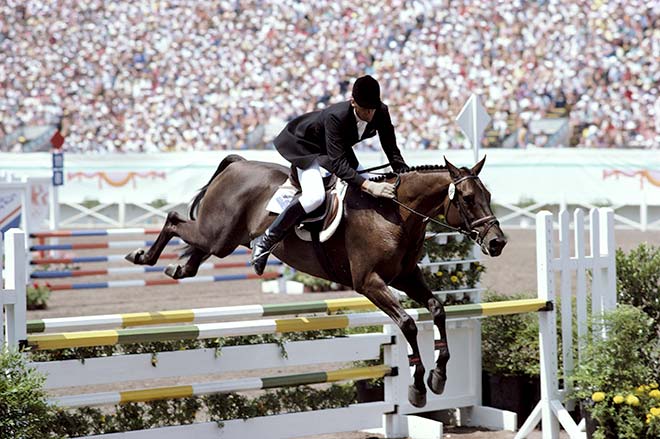
The crowd that packed the stands at Santa Anita in 1984 watched such legendary athletes as eventing Olympic gold medalist Mark Todd of New Zealand on Charisma.
Santa Anita, which has hosted racing’s Breeders Cup, is the track where the great racehorse Seabiscuit won his last race in 1940. The facility also hosts a CSI3* as well as a FEI Jumping World Cup™ Qualifier CSI5*-W, which this year will take place in November.
Santa Anita covers 320 acres and has a grandstand seating 26,000. The track infield area, which resembles a park with picnic tables and large trees, can accommodate a crowd of 50,000. The Park has 61 barns that can house more than 2,000 horses.
by Nancy Jaffer | Apr 9, 2025
The traditional equestrian disciplines of show jumping, dressage and eventing, part of the Olympics since 1912, have been approved by the International Olympic Committee for the 2028 Los Angeles Games.
As usual, there will be individual and team medal competitions in each discipline, with 75 entries for jumping, 60 for dressage and 65 for eventing.
FEI President Ingmar De Vos noted that “The Paris 2024 Olympic and Paralympic Games were a historic success for equestrian sport, which proved very popular with the live crowds and TV and online viewers worldwide. It’s great news that our numbers remain unchanged and we are looking forward to delivering exciting sport at the same level of excellence.”
The qualification systems for the LA28 Olympic and Paralympic Games will be put forward for approval by the FEI General Assembly 2025 this fall and be provided to the IOC for final review and sign off. The rumbling, meanwhile, is that Galway Downs might not be hosting the equestrian competition, although it has the tentative nod at the moment.
Equestrian will be one of the 31 sports on the program of the LA28 Olympic Games. The six medal equestrian events will be part of the 25 mixed events across all sports and the 351 events overall in LA28. The core athlete quota for LA is 10,500, with an extra 698 allocated for the five sports proposed by the LA28 Organizing Committee (Baseball/Softball, Cricket, Flag Football, Lacrosse and Squash).
A record breaking 50 nations participated in equestrian at the Tokyo 2020 Olympic Games. The number of nations in Paris 2024 was 49. Only 30 countries competed in equestrian at the 1984 Los Angeles Games.








